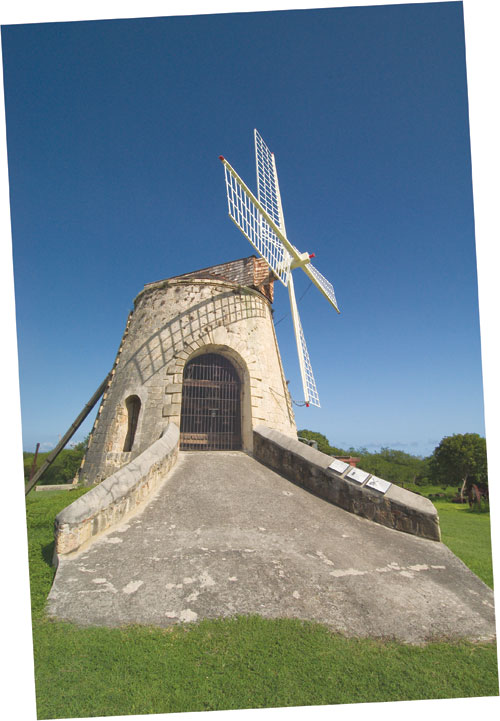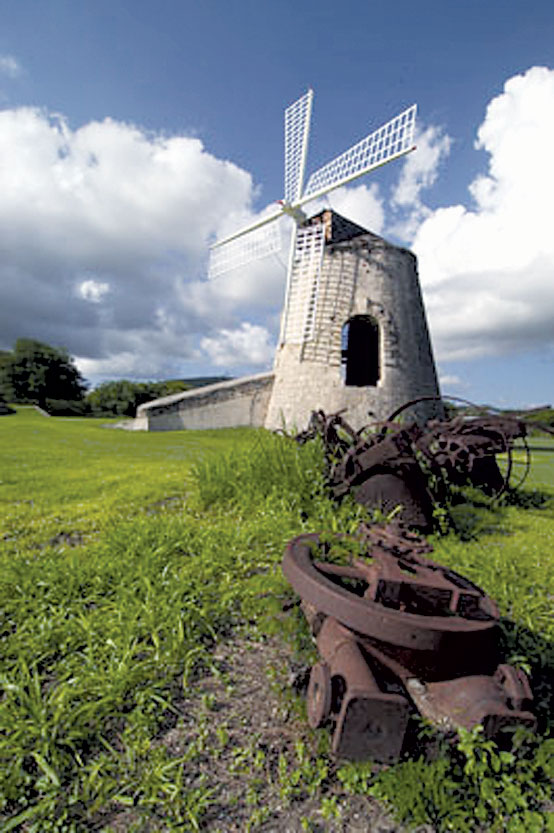 Visitors to the USVI can’t help but notice dozens of huge upside down thimbles that dot our islands’ hills. We call them “sugar mills” because they were built, most in the 18th century, to grind up sugar cane once grown on island plantations.
Visitors to the USVI can’t help but notice dozens of huge upside down thimbles that dot our islands’ hills. We call them “sugar mills” because they were built, most in the 18th century, to grind up sugar cane once grown on island plantations.
If they look like windmills from Holland, it is because they are indeed a Dutch type of mill with a dome at the top, and four canvas sails (later movable wooden shutters or louvers) on wooden arms facing into the wind. Dutch settlers, in fact, introduced sugar cane and the process for making it to the lower West Indies in the early 1600s.
How did the mills work? Inside was machinery, with three upright iron-plated rollers. The middle one, which turned the other two by cogs, was attached by a central pole to the sail and axle mechanism at the top of the mill. Our almost constant trade winds would blow the sails with a strong enough force to turn the works below as cane stalks were fed through the rollers. Juices extracted by the grinding ran downhill to factory buildings where enslaved laborers produced brown sugar, white sugar, molasses, and rum for export. Nothing was wasted — dried out leftover cane stalks became fuel for fires under copper pots used to boil the cane juice.
For a time in the mid-to-late 1700s, St. Croix, under Danish rule, was one of the richest sugar islands in all of the Caribbean with more than 200 sugar plantations. By the mid-nineteenth century, the island’s economy was in a slump as slavery was abolished and sugar beets began to supply Europe. Steam mills eventually replaced wind-driven ones and the iron machinery was taken for scrap during World War I. The shells of stone and coral were left behind on hill tops as empty reminders of the days when sugar was king.
 Where can you visit a sugar mill today? Although many tumbled into ruin by hurricanes and neglect, mills all over the island have been cared for and restored. Of course, courtesy dictates that an invitation is required for a look at ruins on private properties, but there are plenty of mills in public places available for a close up look and photo opportunity.
Where can you visit a sugar mill today? Although many tumbled into ruin by hurricanes and neglect, mills all over the island have been cared for and restored. Of course, courtesy dictates that an invitation is required for a look at ruins on private properties, but there are plenty of mills in public places available for a close up look and photo opportunity.
At the Landmarks Society’s Whim Museum near Frederiksted on St. Croix, tour a preserved mill and the greathouse built by plantation owners, along with outbuildings like the old cookhouse. The society also organizes Sunday Ruins Rambles often that invite you to hike with a knowledgeable guide through historic properties by permission of owners.
Be sure to tour the Cruzan Rum factory, with its mill surrounded by the seven flags that have flown over St. Croix, where you can gain more insight into the historic processes that are still used to produce rum. Sleep beside a sugar mill at spots like the Sugar Beach condominiums, where a free form pool is designed around a 250-year old sugar mill ruin, or tee off near a mill on the grounds of the Carambola Golf and Country Club. You can even find romance among the ruins, such as the restored mill at The Buccaneer, a favorite spot for weddings by the resort’s guests. And don’t forget to take home a reminder of the island’s past — in island shops, you’ll find pottery, paintings and hand-crafted jewelry, all locally made and inspired by our sugar mills’ stone sentinels from centuries past that still symbolize St. Croix today.
